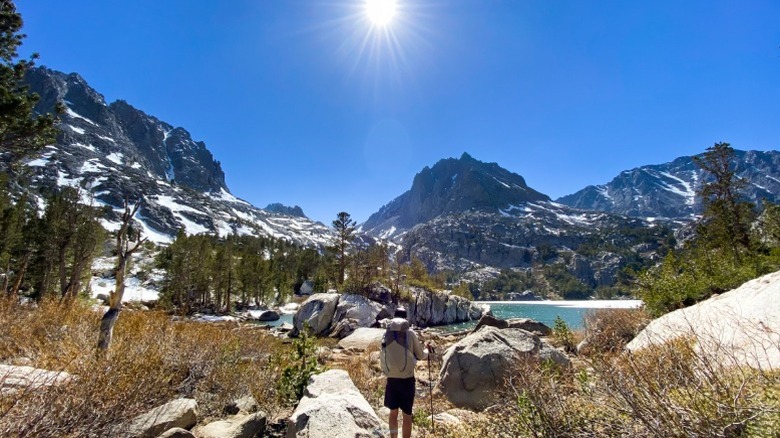Forgot Your Compass? Here Are Simple Ways To Make Sure You Stay On Course
Wandering a little off the beaten path while hiking or backpacking may seem innocent until you've lost your orientation. Trees and undergrowth can quickly blend together if you're not familiar with an area. If you've planned ahead, you'll have all the hiking essentials you need in case of an emergency, including a compass. But you don't have a compass, there's no reason to panic. There's always a way to use your surroundings to stay on course no matter where you are.
If you can find a sturdy, 1-foot-long stick, you can use it to determine the cardinal directions. Assuming there is enough sun, stake the stick into the ground. By watching the movement of the shadow, you can determine your east/west line and north/south line. Place a stone at one end of the shadow made by the stick. After waiting at least 15 minutes, the shadow should have moved. A line drawn between these two points shows the movement of the sun going from east to west.
To find the north/south line, check to see which side the shadow points. That side, in the Northern Hemisphere, will be north. You can then set out on the proper course to complete your hike. However, note that this method offers the most accuracy around the spring and autumn equinoxes.
Find directions using the sun or the stars
If you've strayed off course on a sunny day, don't worry about not having a compass. As long as you can pinpoint the sun in the sky, you can determine where you need to go. To use the sun to mark your directions, you'll need to know what time it is. In the morning, the sun will be in the east. As it moves into the afternoon, it will be in the western part of the sky getting ready to set. The best time to pinpoint your directions using the sun will always be at noon, when the sun is directly overhead.
But when the sun is set and you don't have a compass, is there reason to worry? Thankfully, you can use the stars to guide you as they've guided humans for thousands of years. Just look up and find the North Star, or Polaris, at the end of the Little Dipper constellation, to locate true north. If you cannot see the Little Dipper, locate the Big Dipper first. Draw a line from the two stars at the end of this constellation up to find the North Star.
All that said, when it comes to using your surroundings to find your way, never rely on moss. Despite what you may have heard, moss does not offer the same reliability as orienting yourself using the sun or stars. While some people swear that moss only grows on the north side of trees in the Northern Hemisphere, believing this myth about moss could get you lost in the woods.
Make a DIY compass
You might not have enough sunlight to use the sun accurately to find your way if you get lost. If all else fails, create a simple compass in the middle of the woods. You need a needle or paperclip, a piece of wool or silk, a leaf, and a bit of pooled water to approximate the northerly direction. Take the needle and meticulously rub it against the wool or silk to give it a magnetic charge. If you don't have either of those materials, you can try rubbing the needle through your hair to accomplish this task.
Then take the magnetically charged needle and set it on the leaf (or something else that floats, like a bottle cap) in a pool of water. Try to shelter your compass from the wind, so that the eye of the needle naturally aligns with magnetic north or south (depending on where you're at in the world). This method may not be as accurate as others, but it will help orient yourself enough to continue.
There is a chance that you might not have these supplies if you don't have a compass. If that's the case, you can also turn an analog watch into a makeshift compass. Hold the device horizontally, dial up, and point the hour hand towards the sun. By pinpointing the spot halfway between the hour hand and 12 o'clock, you can determine south. Some issues with this method are that it doesn't consider the time of year and you must adjust the time from 12 o'clock to 1 o'clock during Daylight Savings Time.

